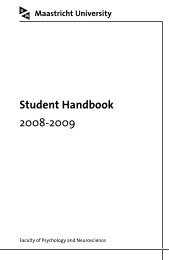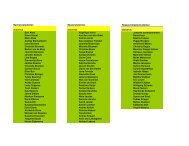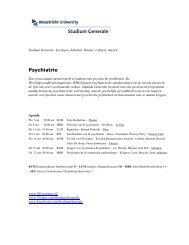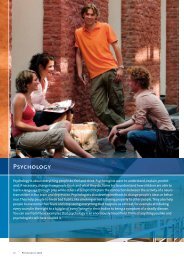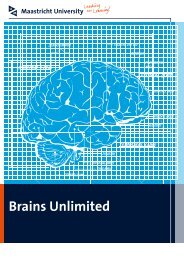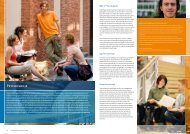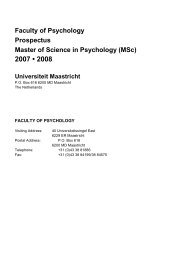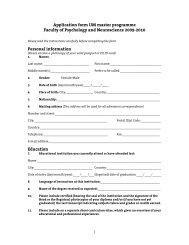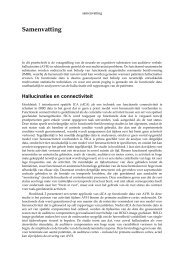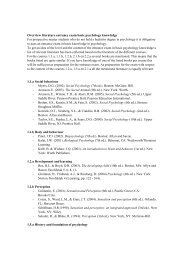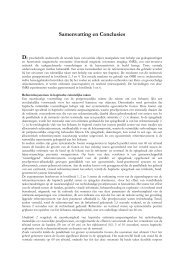Prospectus | 08/09 - Psychology and Neuroscience - Maastricht ...
Prospectus | 08/09 - Psychology and Neuroscience - Maastricht ...
Prospectus | 08/09 - Psychology and Neuroscience - Maastricht ...
Create successful ePaper yourself
Turn your PDF publications into a flip-book with our unique Google optimized e-Paper software.
<strong>Prospectus</strong> Research Master <strong>Psychology</strong> 20<strong>08</strong> • 20<strong>09</strong><br />
| 521CN Diffusion Weighted Imaging <strong>and</strong> Fiber Tracking – 1 credit<br />
Coordinator: Alard Roebroeck, Cognitive <strong>Neuroscience</strong> (FPN), Phone 38 84039,<br />
40 Universiteitssingel East, Room 4.749, E-mail: a.roebroeck@psychology.unimaas.nl<br />
38<br />
Description of the Course<br />
Diffusion weighted imaging <strong>and</strong> fiber tracking are a set of techniques that use the<br />
Magnetic Resonance (MR) scanner to probe fiber-bundles that connect different<br />
regions of the brain. Thus, instead of the cerebral grey matter, it is the white matter<br />
that is the object of study. The connections between brain-regions are the substrate of<br />
the interaction <strong>and</strong> communication between different brain systems. Thus, knowledge<br />
about the anatomy of these anatomical connections is of great importance to cognitive<br />
neuroscientists. The anatomy of fiber-tracts is imaged indirectly, by measuring the<br />
diffusion of water in the brain. Water diffuses more easily parallel to the direction of<br />
surrounding axon-bundles, than perpendicular to it. Thus, by measuring the direction<br />
of local diffusion of water, we can infer something about the trajectories of fiberbundles.<br />
After completing this training, the student will have knowledge of i) how the<br />
MR scanner can be made sensitive to directed diffusion of water <strong>and</strong> how the resulting<br />
diffusion weighted images can be processed, ii) different models for local water<br />
diffusion within a voxel, along with useful quantities that can be derived from them,<br />
iii) fiber tracking or tractography: how to get from local models of water diffusion to<br />
measures of global connectivity between brain regions. Furthermore, the student will<br />
get h<strong>and</strong>s-on experience in analyzing <strong>and</strong> visualizing actual diffusion weighted MRdata,<br />
<strong>and</strong> in using tractography algorithms <strong>and</strong> assessing the results.<br />
Literature<br />
• H<strong>and</strong>outs;<br />
• Journal articles.<br />
Instructional Approach<br />
Lectures, computer sessions, combined in an interactive format.<br />
Form of Assessment<br />
Analysis exercises throughout the training.<br />
| 522CN Data Management – 1 credit<br />
Coordinator: Arjan Blokl<strong>and</strong>, Neuropsychology & Psychopharmacology (FPN), Phone 388<br />
1903, 40 Universiteitssingel East, Room 2.731, E-mail: a.blokl<strong>and</strong>@psychology.unimaas.nl<br />
Description of the Course<br />
The aim of this skills training is to acquire basis skills in data management. After doing<br />
your scientific research, data have to be prepared for data analysis. Usually, the format<br />
of the data acquisition software does not match the requirements of sophisticated<br />
statistical software packages (e.g., SPSS or SAS). In this skills training, students will be<br />
familiarized with the software package Excel. This program has many features that



